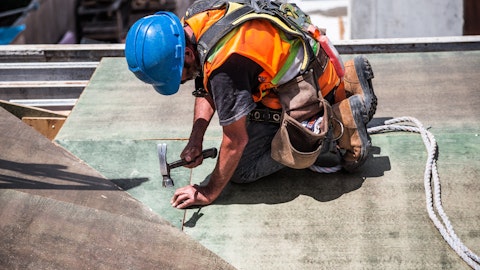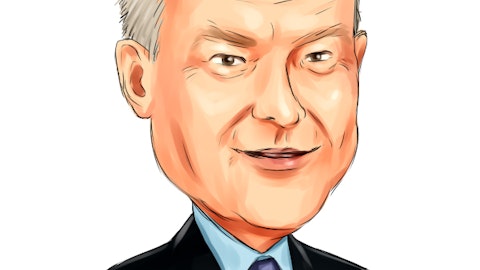Bob Schottenstein: Hi, Jay.
Jay McCanless: Hi. How are you all today?
Bob Schottenstein: We’re doing okay. How are you?
Jay McCanless: Good. Thank you. So with the cycle time, what — on your build to order right now, where’s that looking for a completion time versus where it might have been a year ago?
Bob Schottenstein: Great question. We expect to see cycle time improvement in almost all of our markets in 2023 versus 2022. We have started to see a little bit of that during the last part of 2022. It’s different in every market, because frankly some need to improve more than others. But my guess is that we’ll see anywhere from one week to four weeks in all of our markets this year. And if the average is two or three, that’s — we’re going to try to get more. We’re trying to get back to the pre-pandemic levels. And there’s a lot of landmines, some are on the land — on the municipal side, some are on the supply chain side, although a lot of that’s really gotten — it’s not completely behind us, but a lot of it is.
Jay McCanless: It’s good to hear. What about any benefit from lumber prices coming in? And as part of that, is it likely that the gross margin in the front half of the year is going to be probably at the low end of that range that you talked about just because you’re having to resell some of these cancelled homes?
Phil Creek: Just couple of things, Jay. When you look at the fourth quarter compared to the year ago from that, our fourth quarter sticks and bricks were down a couple of percent overall. We are expecting — don’t have in our numbers or anything, but we are expecting costs to come down a little bit this year. When you look at lumber coming down, we really won’t be getting any benefit of that until like second and third type quarter. As far as margins, our margins did come down from the fourth quarter versus the third. Bob mentioned before, we kind of believe the way the business kind of is, is 2021-’22. We kind of expect margins to be under pressure this year. But having said that, we still expect to have decent margins, but we do expect margins to be more under pressure.
Jay McCanless: And then in terms of getting those cancellations resold, has that — any issues with that or has that been a pretty orderly process?
Phil Creek: It’s actually been a pretty orderly process. We manage the whole thing as far as what we have in the field. I said in my remarks, we had 4,700 homes in the field at the end of the year, down 12% from a year ago. Depending on the product, price point, we may need to get the house in the field by April to get it closed this year, some products are June, July. So that’s just a process you manage overall, and every subdivision is a little bit different. Like Bob said, being able to improve cycle time by a couple of weeks really, really helps us. But we think we’re doing a pretty good job at managing the whole flow of sales, construction. We do keep, in every division, a certain amount of permit ready specs. So if we do have an uptick in sales, we can put a few more specs out there. That’s just part of managing the business.
Jay McCanless: Right. And then on the land side, are you seeing any — maybe a little softer pricing, or is pricing in any areas retreated? Just wondering if some of the lots you may have walked away from, you’re getting to look at them at potentially a little bit better price?
Bob Schottenstein: That’s very market and submarket dependent. What you’re seeing — let me start with this. When things get tough, a lot gets revealed, as they say in life. And one thing that gets particularly revealed in our business is whether or not A locations are really A locations. Because when things get difficult, you really find out what your A locations are, because they still perform at a pretty darn good level. All those other deals that you thought were As or A minuses are probably Cs. So what you’ve seen, and you’ve seen this with us and I suspect from others, most of the stuff that people are walking away from are deals that really don’t pencil well, or at least it’s perceived will not pencil well under current conditions.
I think you may see a little relief on those, because no one’s going to buy it. And there’s an anecdotal — there’s a small example here or there of some moderation or more terms. You don’t have to close in — you don’t have to take it down over three years. You can take it down over five years. And there’s no escalator. That to me is a relaxation of terms. So we’re starting to see a few examples of that. But for the sites that we believe and our competitors believe raise, I think there’ll be very competitive. But for the stuff that’s the more normally B kind of locations, I think that there may be some advantages there. But we’ll just have to see how that plays out. We have a great land position. We don’t need to buy a whole lot. We’re very well positioned this year, next and the following year.
The vintage of almost everything we have on our books is a good vintage. By that I mean I like when we bought it. But we’ll watch and wait. And we’ve always been able to get a — to generate a good return paying retail, as they say. And so we don’t have to go out and buy a whole lot now. But we’re looking at things and if there’s bargains out there, we’re going to jump all over them. Our financial condition is the strongest it’s ever been. Our debt levels, we have zero borrowings on our bank line. And we’re sitting on a lot of cash.
Phil Creek: We own 25,000 lots. And we always talk about, we like to own a two to three-year supply based on current run rate. And right now, we’re a little bit above that. But we feel really good about those 25,000 lots. Of course, we have 17,000 behind that. We did the last half of last year dramatically cut back what we purchased. We were careful on how many developed lots we put on the ground. We did have, as I said, about $10 million of walkaway costs. A number of those deals wasn’t a contract issue. It’s just we don’t think those deals are going to work under current terms. So we are renegotiating certain things. But we’re really in good shape. We don’t have any land banking, a lot of difficult agreements to work through.
When you look at the 17,000 lots we have off the books, the risk dollars are like $75 million. So that’s not a big number. So we very much like the land position that we have. We don’t feel like we need to do much of anything. But certain markets we are looking, there’s always issues here and there. But we feel really good about our land position.





